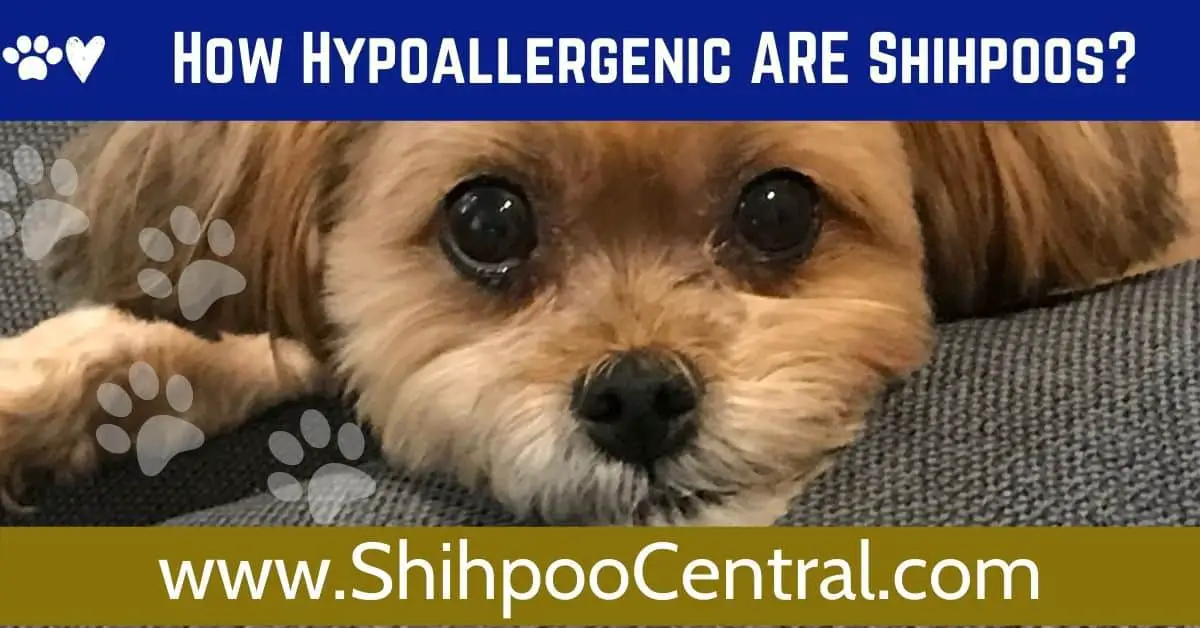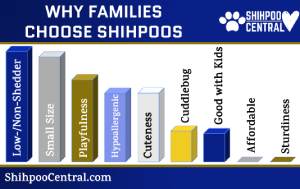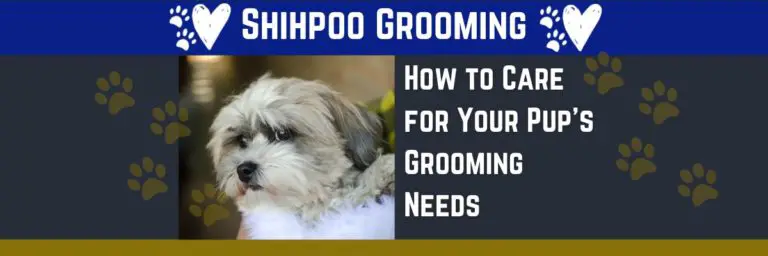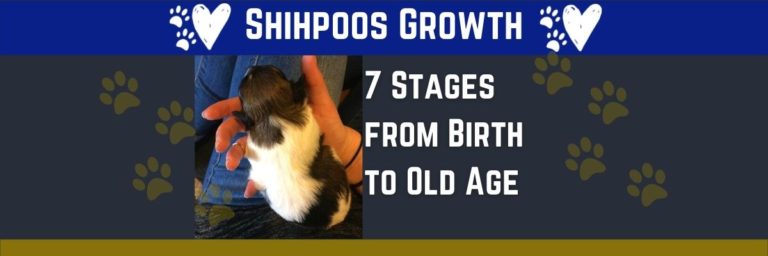Shihpoos Are Great Hypoallergenic Dogs for People with Allergies
Shihpoos inherit hypoallergenic traits from both their Poodle and their Shih Tzu parents. This makes them great companion dogs for people with allergies.
No Dog Is Non-allergenic, but This Doodle Mix Comes Close

Because allergies to pet dander seem so common, many people want to find a hypoallergenic dog breed to minimize the possibility of allergic reactions in their homes, including rashes and breathing troubles. As the offspring or descendent of Shih Tzus and Poodles, Shihpoos are a doogle mix that have a strong tendency to be both hypoallergenic and non-shedding.
Do Shihpoos have hypoallergenic coats?
While most Shihpoo families would consider their puppies to fit the hypoallergenic description, all dogs shed and all dogs have dander. Poodles produce very little dander, and Shih Tzus produce low levels, so Shihpoos tend to cause few if any allergic reactions.
Even with purebred dogs, there are chances puppies might inherit uncommon and even unwanted characteristics. Facebook groups and Instagram posts indicate extremely few problems with shedding and allergies in Shihpoo homes. However, exceptions occur, but if you know what to look for in your Shihpoo puppy, you can maximize the likelihood of bringing home a hypoallergenic, non-shedding puppy.
Shihpoos Inherit Mixed Breed Coats
Shihpoos are a mixed breed, not recognized by the American Kennel Club as a pure-breed. Most Shihpoos have one Shih Tzu parent and one Poodle parent while a few are second or even third generation Shihpoos.
As a mixed breed, Shihpoos have no standards that their breeders try to match. Breeders of purebred puppies like poodles and Shih Tzus, on the other hand, try to raise dogs that will fit within the size, weight, coat type, body shape, and even personality types set by dog clubs.
Shihpoos may inherit more traits from one parent than their other, leading to the variations in size, shape, and coat type typical of mixed breeds. As for their coats, Shihpoos may inherit the tight curls of their Poodle parent or wavy hair more reminiscent of their Shih Tzu parents. Shihpoos that have straight hair like Shih Tzus are extremely rare.
Poodle Coats versus Shih Tzu Coats
Poodles of any size (toy, mini, or standard) have hypoallergenic coats that do not shed much at all. The AKC notes that poodles have “low-allergen” curly coats. Individuals and families looking for a hypoallergenic dog need to remember that “hypo” means low or minimal. No dogs, including purebred poodles, are non-allergenic.
Purebred Shih Tzus have a flowing double coat, so some Shihpoos have wavy hair instead of curly locks. While some Shih Tzu breeders will say their dogs are not considered hypoallergenic, the American Kennel Club includes the breed on its list of recommended dogs for those suffering from allergies.
Consequently, whether your Shihpoo inherits its coat from its Poodle or its Shih Tzu side, it will tend to exhibit hypoallergenic traits.
How to Choose a Hypoallergenic Shihpoo
Generally, though, Poodles tend to produce less dander than Shih Tzus, so a Shihpoo who has inherited more of its Poodle’s parent’s coat will likely have a more hypoallergenic trait than others. How do you know which is which?
Curly Hair Inherited from the Poodle
When we asked the breeder of our first Shihpoo about choosing the most hypoallergenic pup from the litter, she recommended we go with the one who had the curliest hair. This, of course, fell in line with the suggestion above. The curlier the hair, the more Poodle traits the puppy has inherited.
As it turned out, that first Shihpoo really does have very curly hair, even now at four and a half years old. He has a poodle build and athleticism, and his face looks much like a poodle’s face.
Not only have we not had problems with allergies (he sleeps with our middle son who had terrible rashes when we had a Dachshund and a Beagle), but we don’t find his white hair anywhere in the home. His coat is not so curly that it requires daily brushing, but if we’re not careful, it will start to matte after a week or two without brushing/combing.
What about Shihpoos with wavy hair, who seem to have inherited their Shih Tzu parent’s coat? Are they any less hypoallergenic? We can’t point to studies, but our own experience seems to suggest they are similarly good for homes with potential allergies.
Wavy Hair Inheritied from the Shih Tzu
We chose our second Shihpoo from the little based almost exclusively on his energetic nature. He reacted most to our petting and even grunted as we scratched him. So cute!
It wasn’t until we brought him home that we thought about the waviness of his hair. Hardly any curls. We’re glad to report, though, that we have not had any allergic reactions to him. Neither do we find his hair anywhere about the home. Plus, his hair is much easier to brush and comb.
While this is no scientifically sound research, it does suggest the possibility that most Shihpoos, regardless of the curliness or waviness of their coats, will be hypoallergenic. That said, I have read on a few Facebook Shihpoo group pages about a very few Shihpoo families who have had allergic reactions to their Shihpoos and others who have reported shedding.
I don’t know if, in these cases, the Shihpoo caused the allergies or the humans had much more sensitivity to the dog’s dander, even at low levels.
As for the reported shedding, I can’t be sure, but I would not be surprised if the dog in question had more than just a Shih Tzu or Poodle in him or her. Because Shihpoos are not certified by any third-party organization, you really have to trust the breeder and know the pup’s mama and papa to be sure you’re getting a Shihpoo.
Why Do Dogs Cause Allergies

It can seem easy to assume that people with an allergic reaction to dogs somehow inhale tiny dander particles and begin sneezing. Such is an oversimplification.
Dog dander does contain the proteins known to cause allergic reactions, but so does their saliva and so does their urine. Shihpoo family members who allow their puppies to lick their faces or even their lips (not recommended) are much more likely, then, to have an allergic reaction to their puppy’s saliva.
How to Reduce Allergies to Shihpoo Dogs
The main contributor of allergies, when it comes to Shihpoos, involves the proteins in their dander. Let’s state the ugly truth. Dander is made up of dead skin cells. As the Shihpoo’s skin ages, the outermost layer of its epidermis may sluff off or get scraped off. When such cells become airborne (they can be microscopic), a Shihpoo family member can inhale them. If the human has an allergy to Can F I or a Can F II proteins, this can lead to a reaction making it more difficult to breathe (closed sinuses, tightening of the lungs) or keep your eyes open.

Bath Time
To minimize, if not eliminate, your Shihpoo’s dander from your home, start with the most obvious option: bath time. Keep in mind these basics:
- NEVER use human shampoos or soaps. Your precious puppy’s skin and hair care needs differ from your own.
- Some Shihpoo families will insist on top-of-the-line, 100% natural all-organic and very expensive shampoos. After all, these puppies are their babies. We love our puppies too, but our reality involves raising human teens, carrying a mortgage, paying bills, and doing so on a single income. We’ve been using Hartz Ultraguard Rid Flea & Tic (the orange stuff) for two years. You can find it on Amazon here. We have never had a problem with pet dander or dandruff for either of our puppies. That said, Shihpoo skin can vary from puppy to puppy, and what’s good for one may not be good for all.
- Bathe your Shihpoo regularly. Most Shihpoos will need a bath every two to four weeks. However, for the very active Shihpoo, a weekly bath might be in order.
- Do NOT over-bathe your Shihpoo. We’ve gone through periods where our Shihpoos have insisted on playing in the mud every time they go outside for a potty break. If we can get away with it, we just rinse their paws, but sometimes we’ve had to bathe them two or three times a week. This is not recommended for the long-term.
Grooming Time
Groom and brush your Shihpoo regularly. Ideally, if there’s someone in your home who does not have an allergy, he or she will brush your puppy. Regular grooming minimizes the chance of matting that traps dander.
Washing Time
Avoid kissing your Shihpoo. Even if you let your puppy lick your face, as the saliva dries, it releases the allergy-inducing proteins into the air.
Finally, keep your home as clear of your Shihpoo’s urine and feces as possible. If you have trained your puppy to urinate on a pad and don’t dispose of it soon, the Can F I and Can F II proteins may dissipate into the air as the urine dries. The same can be said of the puppy’s poop.
The takeaway? Keep your Shihpoo’s hair well-groomed, wash your face after your puppy kisses you, and dispose of your puppy’s urine and droppings as he or she makes them.
Related Questions
Do Shihpoos shed a lot?
Most Shihpoos shed very little, having inherited low-shedding traits from both their Poodle and Shih Tzu parents. Shedding levels will vary as a mixed breed as well as with the seasons. Some Shihpoo families report never finding Shihpoo hair in their homes.
Are Shihpoos aggressive?
Of the top 10 problems identified by Shihpoo families, none indicated aggression. Most Shihpoo families enjoy loving and sweet relationships with their dogs, who tend to inherit an even-tempered nature from their Poodle parent and a love for attention and affection from their Shih Tzu parent.







